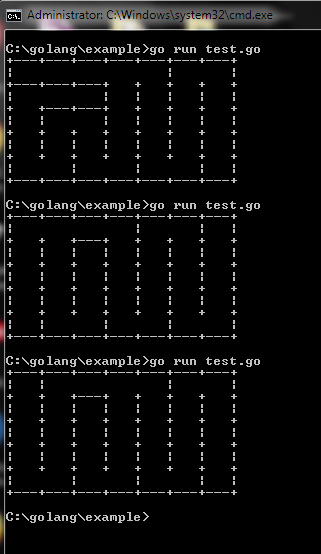Golang program for implementation of Random Maze Generator
A maze can be generated by starting with a predetermined arrangement of cells with wall sites between them. This predetermined arrangement can be considered as a connected graph with the edges representing possible wall sites and the nodes representing cells. The purpose of the maze generation algorithm can then be considered to be making a sub-graph in which it is challenging to find a route between two particular nodes.
Example
package main
import (
"bytes"
"fmt"
"math/rand"
"time"
)
type Maze struct {
c,h,v []byte
cell,hor,ver [][]byte
}
func DrawMaze(rows, cols int) *Maze {
c := make([]byte, rows*cols)
h := bytes.Repeat([]byte{'-'}, rows*cols)
v := bytes.Repeat([]byte{'|'}, rows*cols)
cell := make([][]byte, rows)
hor := make([][]byte, rows)
ver := make([][]byte, rows)
for i := range hor {
cell[i] = c[i*cols : (i+1)*cols]
hor[i] = h[i*cols : (i+1)*cols]
ver[i] = v[i*cols : (i+1)*cols]
}
return &Maze{c, h, v, cell, hor, ver}
}
func (m *Maze) String() string {
hWall := []byte("+---")
hOpen := []byte("+ ")
vWall := []byte("| ")
vOpen := []byte(" ")
rightCorner := []byte("+\n")
rightWall := []byte("|\n")
var b []byte
// for all rows
for r, hw := range m.hor {
// draw h walls
for _, h := range hw {
if h == '-' || r == 0 {
b = append(b, hWall...)
} else {
b = append(b, hOpen...)
}
}
b = append(b, rightCorner...)
// draw v walls
for c, vw := range m.ver[r] {
if vw == '|' || c == 0 {
b = append(b, vWall...)
} else {
b = append(b, vOpen...)
}
// draw cell contents
if m.cell[r][c] != 0 {
b[len(b)-2] = m.cell[r][c]
}
}
b = append(b, rightWall...)
}
// draw bottom edge of maze
for _ = range m.hor[0] {
b = append(b, hWall...)
}
b = append(b, rightCorner...)
return string(b)
}
func (m *Maze) generator() {
// Allocate the maze with recursive method
m.recursion(rand.Intn(len(m.cell)), rand.Intn(len(m.cell[0])))
}
const (
up = iota
down
right
left
)
func (m *Maze) recursion(row, col int) {
rand.Seed(time.Now().UnixNano())
m.cell[row][col] = ' '
for _, wall := range rand.Perm(4) {
switch wall {
// Whether cells up is out or not
case up:
if row > 0 && m.cell[row-1][col] == 0 {
m.hor[row][col] = 0
m.recursion(row-1, col)
}
// Whether cells down is out or not
case down:
if row < len(m.cell)-1 && m.cell[row+1][col] == 0 {
m.hor[row+1][col] = 0
m.recursion(row+1, col)
}
// Whether cells left is out or not
case left:
if col > 0 && m.cell[row][col-1] == 0 {
m.ver[row][col] = 0
m.recursion(row, col-1)
}
// Whether cells to the right is out or not
case right:
if col < len(m.cell[0])-1 && m.cell[row][col+1] == 0 {
m.ver[row][col+1] = 0
m.recursion(row, col+1)
}
}
}
}
func main() {
d := DrawMaze(5,7)
d.generator()
fmt.Print(d)
}

Most Helpful This Week
Golang program for implementation of Quick Sort
Golang program for implementation LZW Data Compression and Uncompression
Golang program for implementation of Selection Sort
Golang program for implementation of Binary Search
Golang program to generate number of slices permutations of number entered by user
Golang program for implementation of Tower of Hanoi Algorithm
